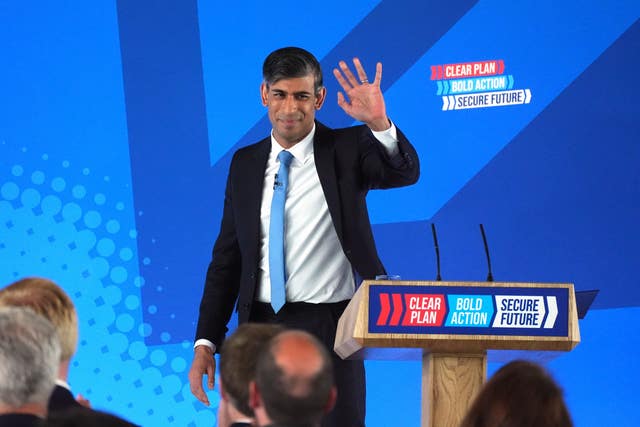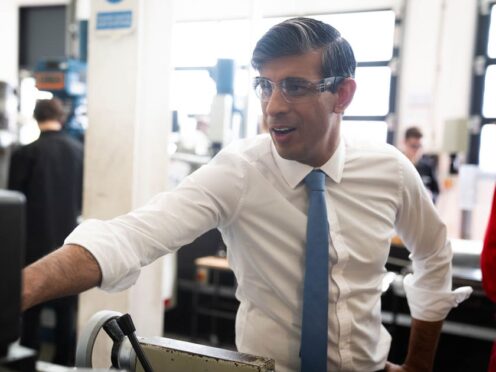The Conservative manifesto’s headline tax cut may not be worth as much as claimed due to thresholds remaining frozen, a leading think tank has suggested.
Paul Johnson, director of the Institute for Fiscal Studies (IFS), also said he had a “degree of scepticism” about the Conservatives’ explanation of how they would pay for the tax cuts and spending promises in their election offer.
In his initial assessment of the Tories’ proposal, Mr Johnson said the 2p cut in national insurance contributions (NICs) for employees would be “more than £10 billion a year”, a similar estimate to the cost of successive 2p reductions at the autumn statement and spring budget.
And of course no hint on how they would make current spending plans add up.
The £5bn of savings scored here from cutting civil service jobs, NHS managers and consultancy spend would be *on top of* the £10-20bn of cuts to "unprotected" depts already pencilled in. https://t.co/ymhTG3XVa2
— Paul Johnson (@PJTheEconomist) June 11, 2024
He said the cut would be worth £450 a year to someone on average earnings of £35,000, adding: “But note they would also lose £150 from continued freezes to income tax and NICs thresholds.”
Mr Johnson also cast doubt on the Conservatives explanation for how they would pay for “some £17 billion per year of tax cuts and a big hike in defence spending”.
He described the promises as “definite giveaways” while branding cost-saving measures aimed at paying for them, including reducing the civil service headcount and the benefits bill, as “unspecific and apparently victimless savings”.
“Forgive a degree of scepticism,” he added.
The IFS director said there was a “real challenge” for the Tories’ plans to lower the amount of working age people out of a job, citing the “ballooned” spending on health-related benefits after the pandemic.
“So, it is right to identify this as a challenge to address. The trouble is the policies that have been spelt out are not up to the challenge of saving £12 billion a year,” he said.
Mr Johnson also said the manifesto “remains silent” on long-term challenges to public spending, adding: “What the manifesto did not tell us was where the £10 to £20 billion of cuts to spending on unprotected public services, as implied by the March budget, might come from.”
Stuart Adam, a senior economist at the think tank, warned of “politically driven pledges” in the manifesto.
He said: “Council tax in England is based on valuations that are already 33 years out of date, with the majority of properties now effectively in the wrong band; not revaluing would entrench the unfairness in a system which must eventually be unsustainable.
“And with petrol and diesel cars due to disappear from the roads – and fuel duty revenues with them – we desperately need a plan for how to tax electric vehicles in the long run; Conservative ministers have repeatedly said they want to replace the lost fuel duty revenue with other taxes on motoring, but in promising not to introduce per-mile road pricing they are now ruling out the best option.”
Mr Adam added: “These are clearly politically driven pledges.
“They are not the promises of a party that is serious about reforming the tax system in ways that would boost growth or remove inequities.
“It is perfectly reasonable for a party to want to cut taxes rather than increase them.
“But the pledges in this manifesto would also rule out vast swathes of sensible structural reform of the tax system.
“The Conservatives have missed opportunities to reform tax in the last 14 years.

“They are making clear that they would continue that trend by essentially preserving the current structure of the tax system in aspic, even as the world moves on around it.”
The Resolution Foundation, a think tank focused on reducing poverty and improving living standards, welcomed the spirit of the tax cuts but said there was “scant detail” about how they would be paid for under current spending arrangements.
Mike Brewer, interim chief executive of the Resolution Foundation, said: “There are big questions over whether doubling down on firm tax commitments, funded by pledges to massively cut spending in record time, really passes the plausibility test, or whether this approach answers the big economic challenge Britain faces on growth.
“The unspoken issue looming over this manifesto is that it will only take a small dose of bad economic news for these plans to fall foul of the fiscal rules, and for a future Conservative government’s tax and spend plans to have to return to the drawing board.”
